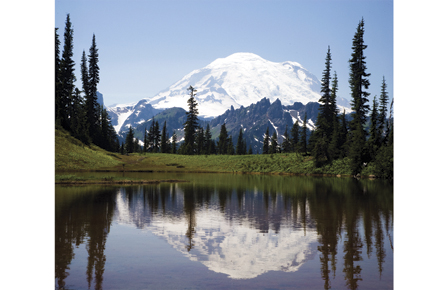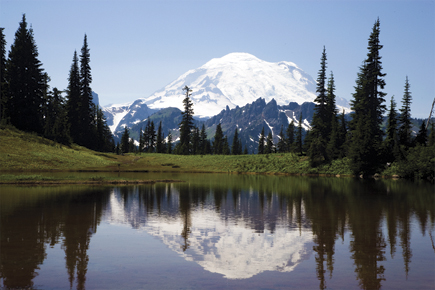Adobe’s Photoshop CS4; Features For Photographers Page 2
Auto-Align works in a similar fashion, placing multiple images onto layers.
 |
|
|
Content Aware Scaling
Hidden away under Edit>Content Aware Scale lays a new and very powerful tool. Content Aware Scaling lets you re-size an image without changing critical visual components, like people and buildings. In the example shown in #9a, I’ve protected Mount Rainier in both the physical and reflected areas, and then pulled in both sides without losing the trees on the left and right sides of the frame (#9b). This is great for those times when you need to fit a specific size but can’t afford to crop the image. You can specify not just the area to protect, but also where to center the scaling reference point.
 |
|
|
Printing
The new print engine in CS4 has much better integration with most popular printers from Epson, Canon, and HP and should make color management issues much less common than before. CS4 also supports 16-bit printing on Mac OS X 10.5 and later, and now has a better soft-proofing preview in the Print dialog with the ability to preview
out-of-gamut areas (#10).
 |
|
|
Camera Raw
If you’ve used Lightroom 2.0, you already know that the raw conversion has greatly improved and the new tools are very useful. Camera Raw 5.0, part of CS4, brings the same tool set and quality to Photoshop and Bridge (#11).
 |
|
|
New tools for localized adjustments and gradients are now available. For example, #12 shows the Graduated Filter tool in use. You can control the size and angle of the effect as well as apply multiple grads to an image. One use I’ve seen for this is to apply a vignette effect to each side of the image.
For the Adjustment Brush, you can easily size the brush and control feathering and opacity to localized areas like the eyes as shown in #13
 |
|
|
Adobe Camera Raw Version 5.0 also supports the new DNG Profile Editor, letting you create or use profiles based on your camera’s Picture Styles. This replaces the old calibration method that was often more trouble than it was worth and consequently avoided by many people. Adobe has presets available for Canon and Nikon cameras on their website (www.adobe.com).
 |
|
|
Bridge CS4
The file management tool included with CS4 has also seen a number of enhancements. First and foremost among these for many users will be the great improvements in speed. Even with large folders of high-resolution images, Bridge keeps up, creating initial thumbnails quickly. Bridge also lets you quickly see where you are in your folder hierarchy by showing the path above the preview area (#14). A set of icons for frequent commands, like sorting, opening an image in Camera Raw, and importing images is also available.
 |
|
|
A new Output panel lets you print or create web galleries directly in Bridge rather than having to launch Photoshop to complete these tasks. There are several presets included with Bridge, and you can add your own. The included Web Gallery templates are the same as those found in Lightroom 2.0 and include both HTML and Flash galleries (#15).
 |
|
|
You can also view and sort by Metadata now (#16), making it easy to find information based on more than date and ratings.
 |
|
|
A Recent icon lets you jump back to previous folders in Bridge, and will also show the recent history from Photoshop, navigating to and selecting that file in Bridge. Finally, you can now create Collections in Bridge. Collections are similar to those in Lightroom—they are virtual pointers to files on your computer. The physical file isn’t moved, and removing a file from a Collection doesn’t affect the physical file.
Conclusion
Photoshop CS4 is a solid upgrade to one of the most popular image-editing programs. With a good mix of new features and improvements to old favorites, this is a worthwhile upgrade. If you skipped CS3, now is the time to move forward. In particular, the improved raw processing and the new Adjustments panel are a key part of my workflow when in Photoshop. Tighter integration with Lightroom 2.0 is a welcome addition, and the ability to perform better soft-proofing in the Print dialog is also helpful. Niceties like the ability to rotate your image, making working with a tablet even easier than before, and the new Scaling and Blending tools, along with much improved masking features, make complex adjustments much easier to perform. Bridge has really improved, and could very well be the only image management program you’ll need. CS4 is still a big and complex program that probably does more than most of us will ever need. Only you can decide if CS4 is the right option for you, but it’s certainly not a program you’ll ever outgrow!
For more information, contact Adobe Systems Inc., 345 Park Ave., San Jose, CA 95110; (800) 833-6687; www.adobe.com.
(Editor’s Note: We will have a full review of specific features within the program in a future issue.)
Jon Canfield is the author of several books on digital imaging and printing. A popular instructor at BetterPhoto.com, Canfield also teaches workshops for the Panasonic Digital Photo Academy (www.digitalphotoacademy.com). You can reach Canfield via e-mail at: jon@joncanfield.com.
- Log in or register to post comments

































